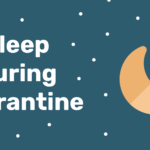Written and medically reviewed by Rich LaFountain, PhD
If you want to feel peppier, be healthier, and live longer, healthy sleep is essential. Unfortunately, up to one third of adults have difficulty getting quality shut-eye — so if you’re struggling, you’re not alone.
Better sleep can pay huge dividends, so let’s look at what constitutes “healthy sleep” and how to achieve it.

What Is Healthy Sleep?
Sleep is non-negotiable. Every human, animal, and even plant (at least on planet Earth) sleeps. During sleep, nearly every cell in your brain and body slows down, recovers, and resets for the day ahead. But just because everyone sleeps doesn’t mean that they’re experiencing healthy sleep.
Healthy sleep provides an adequate duration of rest to your body, during which your brain exhibits a defined pattern of brain activity — all of which results in waking up refreshed and energized. Long gone is the belief that just staying in bed for 8 hours meant you’d met your healthy sleep requirements. Besides duration, healthy sleep involves a balance of sleep stages and even transitions between sleep cycles that all contribute to how you feel and function in your daily life.
The Key Principles of Healthy Sleep
While much can be said about the states, stages, and cycles of sleep, healthy sleep boils down to two key principles:
- Sleep duration, or getting enough total sleep.
- Sleep dynamics, or getting the right balance of sleep cycles during sleep.
Sleep Duration
In prioritizing healthy sleep, the first and most obvious place to focus is sleep duration. A century ago, humans slept, on average, 9 hours per night. Today, the average adult sleeps only 6.8 hours.
Too little sleep (6 hours or less) has a whole host of negative health effects, from obesity to high blood pressure to a weakened immune system. However, too much sleep (9+ hours, unless you’re ill or recovering from sleep debt) can be just as bad. There’s a u-shaped association between sleep duration and all-cause mortality: getting less than 6 hours or more than 9 hours of sleep both contribute to increased metabolic dysfunction and disease risk.
According to the American Academy of Sleep Medicine and Sleep Research Society, you should aim to get 7–9 hours of sleep each night. Considering it takes the average healthy sleeper 10–20 minutes to fall asleep, “8 hours in bed each night” is a good minimum target, provided you’re confident you can fall asleep in under an hour.
Sleep Dynamics
Once your sleep duration is in a healthy range, it’s time to consider your sleep dynamics. These are the patterns, cycles, stages, and brain wave activity you experience when you sleep. Tomes of research have been dedicated to sleep dynamics; here we’re reviewing two primary sleep states, non-rapid eye movement sleep (NREM) and rapid eye movement sleep (REM).
When you first fall asleep, you’re experiencing NREM. During this state, your body temperature, heart rate, blood pressure, and metabolism reach their lowest point. You’ll also experience an increase in human growth hormone, which stimulates fat burning.
Normally, NREM sleep makes up about 75% of total sleep duration, or roughly 360 minutes (6 hours) if you sleep 8 hours. Without sufficient NREM sleep, your body has a hard time recovering, even from normal daily wear and tear. The first noticeable sign is usually fatigue in the morning or throughout the day. Over time, you may see your weight loss or strength gain efforts plateau — that’s because your body isn’t getting enough NREM time to repair muscles and burn fat. However, if you’re noticing a decline in NREM sleep over years or even decades, don’t fret; an age-related decline is normal. Research suggests that taking daytime naps of up to 90 minutes can help boost your total daily NREM sleep duration, if you find it slipping.
Later in sleep, you’ll spend more time in the REM state. During REM sleep, you breathe faster; your cortisol levels rise; and your heart rate, body temperature, and blood pressure are variable. The important activities going on during REM sleep are mainly in your brain: you consolidate emotional memory and prepare for wakefulness. However, REM sleep conveys less rest to your body than NREM sleep, which is why a balance between the two is so important.
Achieving this balance requires, much to many people’s chagrin, an evening bedtime. As the hour gets later, your sleep cycles naturally shift toward more REM sleep. Therefore, when you go to sleep late — for example after midnight — your body compensates by accelerating your sleep dynamics, and your total REM sleep is increased at the expense of NREM sleep. Normal REM sleep in healthy adults totals 20–25% of total sleep duration, or about 120 minutes. When you get too much REM sleep, you might experience more nightmares, and you can often wake up during a REM cycle, which predisposes you to fatigue. (As you can imagine, waking during any sleep stage interrupts the important biological processes going on.)
Your sleep duration and sleep dynamics can have a huge impact on whether or not you feel refreshed and rested upon waking. So while tracking sleep duration, sleep scores, or individual sleep metrics can be helpful, don’t underestimate the value of your own perceived energy levels when gauging whether or not you’re getting consistent, healthy sleep.
How to Start Building Healthy Sleep Habits
You have the power to experience healthy sleep night after night. Sure, there will be times when your routine is thrown off by life events, but nailing some basic habits will get you back to a healthy sleep schedule in no time.
#1. Use Fasting and Food to Align Your Circadian Rhythm with Day/Night
To help your body differentiate active daylight hours from nighttime sleep, begin your overnight fast 2–4 hours before you go to bed. Adding specific foods to your diet can help you sleep better, as well.
#2. Get Regular Physical Activity
Research has shown that low physical activity can result in trouble sleeping. Conversely, being physically active for 50 minutes 3x/week reduces pre-sleep anxiety, increases total sleep time, and improves sleep quality. If you want to improve your sleep, shore up your daytime movement habits.
#3. Leverage Your Morning Routine
It’s easy to overlook, but what you do each morning significantly impacts your sleep. When you wake up, do your best to signal to your body that sleep time is over. Prioritize getting sunlight or bright light exposure, which helps set your body’s internal clock to follow a natural light-dark cycle. In addition, you can reduce sleep inertia or grogginess by engaging in gentle early-morning activities like walking, stretching, or yoga.
#4. Clean Up Your Evening Routine
By now you’ve probably heard: Sleep hygiene is important. Make sure your bedroom is cool and dark, to support your body’s natural temperature and hormonal shifts as it prepares for healthy sleep. Additionally, if you find yourself lying awake in bed, try some non-sleep deep rest strategies like yoga nidra to fall asleep up to 40% faster.
Conclusion
Sleep is both mandatory and natural, but that doesn’t mean it can’t be improved. Make sure you’re taking steps to get healthy sleep each night, and watch the beneficial effects spill over to your daytime activities and beyond.
- Debunking 3 Myths Around Fasting and Thyroid Health - April 15, 2024
- Breaking Down Fast Breakers: How to Tell If Something Will Break Your Fast - March 4, 2024
- GLP-1s and Weight-Loss Medications vs. Lifestyle Interventions: What’s Right for You - February 5, 2024






